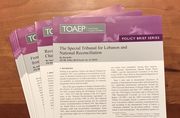Table of contents:
Element:
ICC
In the Katanga Trial Judgement, the Trial Chamber held that:
"It cannot be inferred from the use of the future tense and words or expressions such as "will occur" or "in the ordinary course of events" that the drafters of the Statute intended to include dolus eventualis, that is, awareness of the existence of a mere likelihood or possibility. However, neither need the volition to cause the consequence in question be established - since article 30(2)(b) is intended to furnish an alternative to dolus directus of the first degree - or even the absolute certainty that that consequence will occur in future, which by definition is impossible to prove.
The words "will occur", read together with the phrase "in the ordinary course of events", make clear that the required standard of occurrence of the consequence in question is near but not absolute certainty. The standard is therefore "virtual certainty", otherwise known as "oblique intention". The Chamber considers that the words used in article 30 are sufficiently clear for it to be able to rule in this connection. It therefore adopts the findings of Pre-Trial Chamber II in Bemba.
Thus, this form of criminal intent presupposes that the person knows that his or her actions will necessarily bring about the consequence in question, barring an unforeseen or unexpected intervention or event to prevent its occurrence. In other words, it is nigh on impossible for him or her to envisage that the consequence will not occur."[43]
The Pre-Trial Chamber in the Banda and Jerbo case held that:
"As regards the subjective element of the attempted murders, as this Chamber has previously stated elsewhere, "the attempt to commit a crime is a crime in which the objective elements are incomplete, while the subjective elements are complete", Therefore, no distinction will be made in the assessment of the subjective elements in relation to murders, whether attempted or completed."[1]
ICTY
According to the Kordić Trial Judgment:
"The Trial Chamber in the Mucić et al. (?Čelebići?) case was the first to identify the ingredients of the offence of wilful killing in Article 2(a) of the Statute. That finding was adopted by the Trial Chamber in the Blaškić case. This Chamber can see no reason to depart from the findings of the Mucić et al. (?Čelebići?) and Tadić Trial Chambers on this matter. Accordingly, the Chamber finds that, in relation to the crime of wilful killing, the actus reus - the physical act necessary for the offence - is the death of the victim as a result of the actions or omissions of the accused. In this regard, the Chamber observes that the conduct of the accused must be a substantial cause of the death of the victim, who must have been a "protected person". To satisfy the mens rea for wilful killing, it must be established that the accused had the intent to kill, or to inflict serious bodily injury in reckless disregard of human life."[2]
"Having repeated elements 1, 4, and 5 of this offence as listed in its Pre-trial Brief, the Prosecution further submits that "the underlying offence wilful killing under Article 2, and the crime of murder as provided for in Common Article 3 and Article 5 of the Statute, apart from their respective jurisdictional conditions, require the same actus reus and mens rea", referring to a statement of the Mucić et al. (?Čelebići?) Trial Judgment that "[t]here can be no line drawn between 'wilful killing' and 'murder' which affects their content."[3]
The Trial Chamber in the Vasiljević Case presented one more possibility:
"Counts 4, 5, 10 and 11 charge the Accused with murder, a well-defined crime under customary international law. The elements of the definition of "murder" under customary international law are as follows:
1.1. The victim is dead.
1.2. The death was caused by an act or omission of the accused, or of a person or persons for whose acts or omissions the accused bears criminal responsibility.
1.3. That act was done, or that omission was made, by the accused, or a person or persons for whose acts or omissions he bears criminal responsibility, with an intention:
To kill, or
To inflict grievous bodily harm, or:
"To inflict serious injury, in the reasonable knowledge that such act or omission was likely to cause death."[4]
The Blaškić Trial Chamber stated:
"The Trial Chamber hearing the Mucić et al. (?Čelebići?) case defined the offence of wilful killing in its Judgment. For the material element of the offence, it must be proved that the death of the victim was the result of the actions of the accused as a commander. The intent, or mens rea, needed to establish the offence of wilful killing exists once it has been demonstrated that the accused intended to cause death or serious bodily injury which, as it is reasonable to assume, he had to understand was likely to lead to death."[5]
According to the Trial Chamber in Mucić et al. ("Čelebići") Trial:
"On the basis of this analysis alone, the Trial Chamber is in no doubt that the necessary intent, meaning mens rea, required to establish the crimes of wilful killing and murder, as recognised in the Geneva Conventions, is present where there is demonstrated an intention on the part of the accused to kill, or inflict serious injury in reckless disregard of human life. It is in this light that the evidence relating to each of the alleged acts of killing is assessed and the appropriate legal conclusion reached in Section IV below."[6]
In the Milutinović et al. case, the Trial Chamber held that:
"The mens rea for murder is satisfied when the Prosecution proves one of two alternative
mental states beyond a reasonable doubt: the physical perpetrator either intended his act or:
"omission to cause the death of the victim [...]. The mens rea can also be fulfilled by the intermediary perpetrator or the accused."[7]
Prosecutor v. Radovan Karadžić, Case No. IT-95-5/18-T, Public Redacted Version of Judgement Issued on 24 March 2016 – Volume I of IV (TC), 24 March 2016, paras. 447-448:
"447. In order to satisfy the mens rea of murder, the Prosecution must prove that the act was committed, or the omission was made, with an intention to kill (animus necandi) or to wilfully cause serious injury or grievous bodily harm which the perpetrator should reasonably have known might lead to death."
"448. Thus, the mens rea of murder includes both direct intent (dolus directus), which is a state of mind in which the perpetrator desired the death of the individual to be the result of his act or omission, and indirect intent (dolus eventualis), which is knowledge on the part of the perpetrator that the death of a victim was a probable consequence of his act or omission."
ICTR
The Trial Chamber in the Semanza Case raised the issue of premeditation and stated:
"Murder under Article 4 refers to the intentional killing of another which need not be accompanied by a showing of premeditation. The Chamber reaches this conclusion having considered the use of the term "meurtre" as opposed to "assassinat" in the French version of the Statute."[8]
SCSL
The Taylor Trial Chamber found:
"Given that perpetrators summarily executed the civilian suspects without trial and left their bodies lying in full public view for three days before taking them away, the Trial Chamber finds beyond reasonable doubt that Sam Bockarie wilfully made the victim the object of such violence with the primary purpose of the killings to instil terror in the civilian population in Kenema Town."[9]
As to another event, the Taylor Trial Chamber found:
"Although Bao's evidence as to who killed this man is circumstantial, the Trial Chamber finds that the circumstances surrounding that death, including the bizarre conduct of the AFRC/RUF fighters in dancing and singing aloud that "they had captured and killed the Kamajor boss", and disembowelling his body and using the entrails as a "check point", all reasonably lead to one inference that the AFRC/RUF fighters intentionally killed this civilian suspecting him of being a member of the Civil Defence Force, a perceived enemy of the AFRC/RUF forces. Accordingly, the Trial Chamber finds that the Prosecution has proved beyond reasonable doubt that in December 1997 on Hangha Street near the Sierra Leone Telecommunication house, the AFRC/RUF fighters intentionally killed a civilian that was not taking an active part in hostilities.
"Given that this killing was part of the operation code-named "Operation No living thing", the AFRC/RUF fighters' bizarre conduct in disembowelling the man's body and using the entrails as a "check point", and in leaving his body on public display for three days before removing it, the Trial Chamber finds beyond reasonable doubt that the perpetrators wilfully made the victim the object of such violence with the primary purpose of the killing to instil terror in the civilian population in Kenema Town."[10]
Footnotes:
[1] ICC, Banda and Jerbo Decision on confirmation of charges, 7 March 2007, para.106.
[2] ICTY, Kordić and Cerkez Trial Judgment, 26 Februrary 2001, para. 229.
[3] ICTY,. Kordić and Cerkez Trial Judgment, 26 Februrary 2001, para. 233.
[4] ICTY, Vasiljević Trial Judgment, 29 November 2002, para. 205.
[5] ICTY, Blaškić Trial Judgment, 15 July 1999, para. 153. See also ICTY, Naletilić and Martinović ("Tuta and Štela ") Trial Judgment, 21 March 2003, para. 248.
[6] ICTY, Mucić et al. ("Čelebići") Trial Judgment, 16 November 1998, para. 439.
[7] ICTY, Milutinović et al. Trial Judgment, 26 February 2009, au para.138.
[8] ICTR, Semanza Trial Judgment, 15 May 2003, para. 373.
[9] SCSL, Taylor Trial Judgment, 18 May 2012, para. 603.
[10] SCSL, Taylor Trial Judgment, 18 May 2012, para. 605-606.







